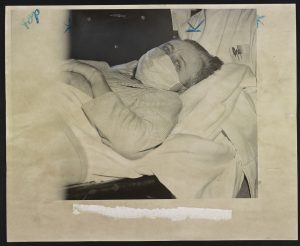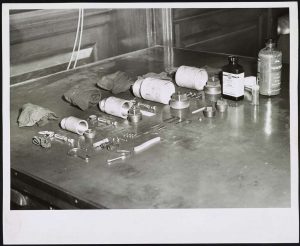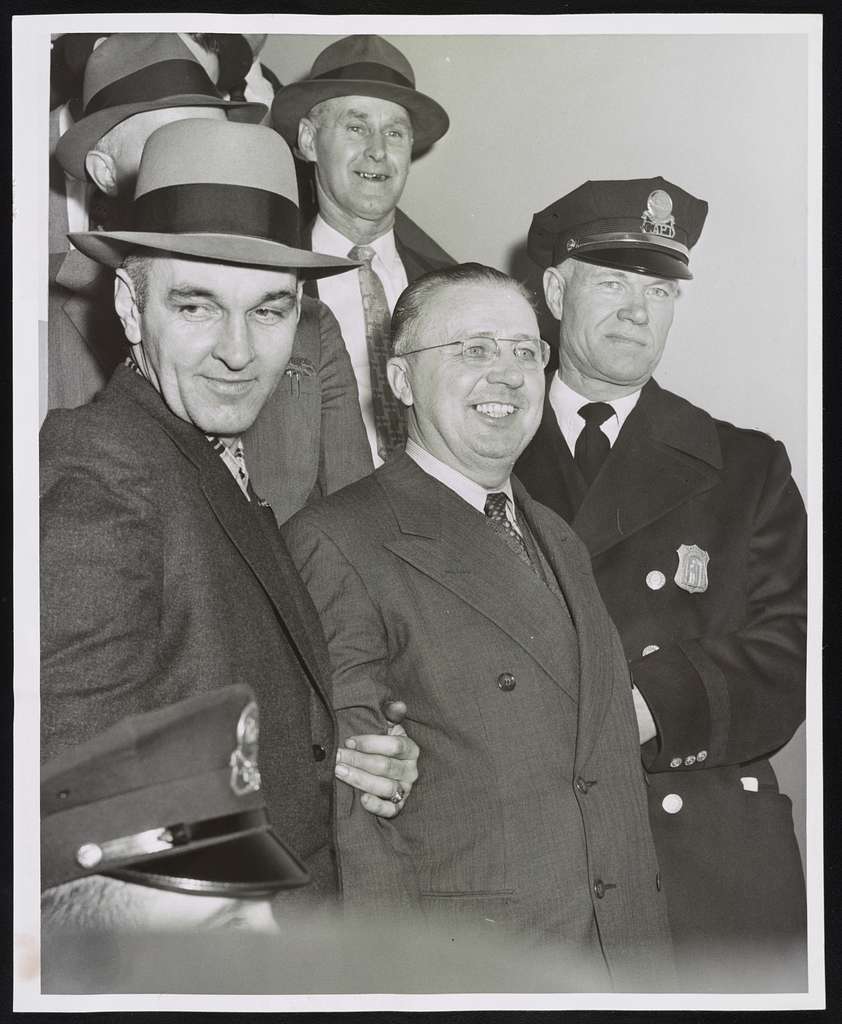It was early December of 1956 in New York City. New Yorkers were in a state of vigilance because of bombs left around public places by a person or group of people known as “The Mad Bomber,” and in the newspapers they were mentioned as “the greatest individual menace New York City ever faced.”1 Without any leads on who the suspect or suspects might be, the New York Police Department decided to take a new approach, which was still under development, but would come to be known as criminal profiling.
On September 5, 1931, George Metesky, a.k.a. “F.P.,” was working at a Consolidated Edison power plant in the Bronx when he was exposed to harmful gases, which he claimed left him with chronic tuberculosis. The utility company placed him on sick leave from his $37.50 a week job and recommended that he file a disability claim; but doctors could not find anything wrong with him, which resulted in him getting fired for lack of substantiating evidence of workplace injury.2 His anger against both the state and the company turned into rage and violence, which New York City was not prepared to face. He devised a plan to “punish” Con Ed and the state by putting homemade bombs in public places all throughout Manhattan and Brooklyn. His first attack occurred on November 16, 1940, when he put a pipe bomb in a toolbox alongside a note that read, “Con Edison crooks, this is for you,” and left it at a window ledge of the Edison Building in Manhattan.3 The bomb did not detonate, and investigators’ curiosity rose after seeing the bomber’s note attached to the bomb, which would have been destroyed if the bomb had gone off. So, they thought that perhaps the bomb was meant to be a threat and not a real weapon.4
In September 1941, “F.P.” planted his second bomb a few blocks from Con Ed’s main offices at Irving Plaza, which did not detonate either.5 An alarm clock was set as the trigger mechanism this time and investigators were once again filled with curiosity. After examination, the police concluded that the same person was responsible for both bombs and that he must be holding a grudge of some kind against Con Ed. That same year, they received reaffirmation of their assumption after receiving a letter that read, “I will make no more bombs for the duration of the war – My patriotic feelings have made me decide this – Later I will bring the Con Edison to justice – They will pay for their dastardly deeds. F.P.”6 Just as Metesky promised, the bombings stopped for the duration of World War II, and dozens of letters were received by various New York City businesses that talked about more future bombings and about his repeated calls for justice. From 1946 to 1950, the letters stopped, and no one heard anything further from “F.P.”7
On March 29, 1950, the bomber made his comeback official after a third unexploded bomb was found in New York’s Grand Central Station. The bomb was bigger and more sophisticated than the previous bombs, meaning that it was only a matter of time before one of “F.P.’s” bombs manage to go off and cause real damage. On April 24, 1950, one of “F.P.’s” bomb detonated, causing property damage to a telephone booth at the New York City Public Library. By Christmas 1950, “F.P.” had planted or mailed at least eight bombs around New York City, but just before the New Year, he wrote to the New York Herald Tribune expressing his dissatisfaction with the lack of media attention he was getting, and he threatened more bombings to “show how important I am.”8 This letter read:
“To Herald Tribune Editor–Have you noticed the bombs in your city–if you are worried, I am sorry–and also if anyone is injured, but it cannot be helped–for justice will be served. I am not well, and for this I will make the Con Edison sorry–Yes, they will regret their dastardly deeds–I will bring them before the bar of justice–public opinion will condemn them–for beware, I will place more units under theater seats in the near future. F.P”9
For the next two years, “F.P.” planted four sophisticated bombs that went off, two of them in movie theaters, one in a subway locker, and another in a telephone booth. By this point, his presence in the media and in the public was apparent. He was dubbed “The Mad Bomber.” While the hunt for the Mad Bomber was on, “F.P.” continued with his bombing, setting four bombs in 1953 and another four in 1954, including one in the Radio City Music Hall that injured four people. In 1955, he set six bombs, two of them did not explode, the other four did, one almost killing a porter at Grand Central Station.10
After seeing his growing “success,” “F.P.” was motivated to continue his bombings and even decided to step up his letter writing. In March 1956, he wrote once again to the Herald Tribune expressing again his anger over the lack of media presence. He stated the number of bombs he had placed at 54, as well as his threat to place more bombs. True to his word, he set various bombs in public places around the city, one in Macy’s that left six people injured, another one that exploded in an RCA guard’s kitchen after the guard found it in a phone booth and took it home with him without knowing it was a bomb.11
The beginning of the end for the Mad Bomber was on December 2, 1956, when at 7:50pm, one of his pipe bombs went off at the Paramount Theater in Brooklyn, during a showing of “War and Peace,” where 6 to 15 among 1,500 people were injured. It was the most powerful out of all the other bombings.12 Four days after the bombing, the New York City Police Department set their “greatest investigation in department history.”13 Commissioner Kennedy ordered all the chiefs from every station by saying, “Alert every member of the force, regardless of assignment, to the necessity of making an apprehension. The man is not in his right mind.”14

After that, the commissioner decided to finally ask the press for help and began disclosing reams of evidence to reporters that dated back to 1940. This led to many hoaxes and false alarms, which is what the police had feared, but that did not stop Kennedy. On December 10, Kennedy distributed to reporters a sheet containing fragments of “F.P.’s” unusual handwriting, which were looked at by a graphologist-psychiatrist, who said that it revealed a “deterioration of the bomber, mentally and physically, and increasing aggressiveness in his disordered desire to make his presence felt.”15 Meanwhile, on December 16, “F.P.” struck again when a bomb was reported in a post office on the main street of Flushing, Queens. Captain Finney and his men were chasing hoaxes while “F.P.” continued with his daily activities. Without any leads, the manhunt found itself at a dead end.16
By mid-December of 1956, Captain Finney, as head of the crime lab, had confined himself to the scientific treatment of physical evidence, but he started doubting the current path of the investigation and expressed his doubts to trusted colleagues. He believed that if they did not find a useful lead quickly, it was only a matter of time before “F.P.” would kill someone. He began to wonder whether there was possibly another way to interpret the evidence that they had not considered before. Perhaps the letters contained “F.P’s” motivation in between the lines? So, while Commissioner Kennedy sought for answers out in the public, Captain Finney, alongside Captain John J. Cronin, discreetly looked for someone that could provide a new perspective to the case. Captain Cronin proposed a long-shot idea to Captain Finney. Six years ago, Cronin met Dr. James A. Brussel at a convention in Elmira, New York. Cronin described Dr. Brussel as a “sharp-witted psychiatrist that offered an uncommon insight to the working of a criminal mind.”17
In 1956, criminal profiling was a thing of fiction that was only to be found in an Edgar Allen Poe novel. Still, Captain Finney was intrigued by the possibility of it. This was a radical notion in 1956. Captain Finney thought that maybe Dr. Brussel could draw an emotional portrait from the evidence, illuminating “F.P.’s” background and disorder, in light of the fact that a physical description of the bomber was unobtainable. Captain Cronin called Dr. Brussel to ask if he would be willing to participate on the case, but despite being fascinated by the case, Dr. Brussel hesitated to accept the offer. He first cited the demands of his work and private practice. Another reason was that in the 111 years of the Police Department, no one had ever asked a psychiatrist to draft an emotional portrait of such a criminal, and much less so in a case of such high-profile. He feared that his analysis would fail to break the case or that he would send the police in the wrong direction. “I felt that my profession was being judged, as well as myself. And curiously, I was one of my own accusers in this bizarre trial of wits. Did I really know enough about criminals to say anything sensible?…I’d seen hundreds of offenders in my career, but had I learned enough from them and about them?”18
Dr. Brussel told Cronin, “I don’t know what you expect me to do.” Cronin answered, “Sometimes the difference between failure and success is a new thought.”19 After much debate, Dr. Brussel could not turn away the chance to work on the city’s greatest manhunt. Then, Captain Finney, accompanied by two bomb squad detectives, met with Dr. Brussel at the Department of Mental Hygiene on Chamber Street, where Dr. Brussel’s office was. Captain Finney took a seat facing Dr. Brussel and presented him a collection of evidence on the case, and said “We’d appreciate any ideas you might have on this case, Doctor. Our case is straw-grasping. We’re stumped. Here’s a bundle of letters and photographs. Solve it.”20

Dr. Brussel saw the genuine interest that Captain Finney had about his insight on the case, but still recognized that no matter how insightful he was, many others in the force would reject psychiatry as a legitimate tool for crime-solving. Still, Dr. Brussel talked for two hours about what the evidence revealed about the culprit. “When you think about an unknown criminal long enough, when you’ve assembled all the known facts about him and poked at them and stirred them about it in your mind, you begin to see the man. You see him more and more plainly. You picture his face, hear his voice.”21 After a long pause of overlooking City Hall by the window, he began to describe the bomber. Dr. Brussel said the bomber was a textbook paranoid schizophrenic, “We all get mad at other people and organizations sometimes, but with most of us the anger evaporates eventually. The paranoiac’s anger doesn’t. Once he gets the idea that somebody has wronged him, the idea stays in his mind.”22
He also took a guess at his age from the diagnosis, explaining that most paranoids don’t become fully symptomatic until after the age thirty, and if the bomber had planted his first bomb in 1940 then he would be around his mid-forties or older by 1956. Dr. Brussel paused for a second and continued: “the bomber is symmetrically built…neither fat nor skinny.”23 He cited the work of a German psychiatrist, Ernst Kretschmer, who did a study of body types and their correlated pathology. Dr. Brussel concluded that the majority of paranoids had an “athletic” body and that there was a 17 in 20 chance that the bomber fell in that category.24 He also described the bomber as a “very neat, proper man” due to the prissiness shown in the letters, adding that when they arrested him, “F.P.” would be wearing a double-breasted suit and said “it will be buttoned.”25
Dr. Brussel later explained that due to “F.P.’s” paranoia, he believed that various companies had conspired with Con Ed, and that is why he bombed theaters and train stations. “Paranoids have confidence only in themselves. They distrust everyone,” explained Dr. Brussel, therefore implying that “F.P.” worked alone.26 Due to “F.P.’s” use of old-fashioned phrases, Dr. Brussel believed that he was a foreigner, which the police also had suspected for a while as well, but Dr. Brussel explained that “bombs have been favored in Middle Europe. So have knives, but when a man uses both, that suggests he could be a Slav.”27 This also led to the deduction that he could be Roman Catholic and that he probably resided in one of the industrial towns of Connecticut where Slavic immigrants had settled.28
Four hours later, the detectives had gathered all the information Dr. Brussel had provided and were ready to leave when Dr. Brussel stopped them and told them “I think you ought to publicize the description I’ve given you. Spread it in the newspaper, on radio and television.”29 He told the police that “F.P.” craved attention and that he would not be able to keep himself from responding once he saw the profile. So, on December 25, 1956, the bomber’s profile was published in all New York newspapers:
“Single man, between 40 and 50 years old, introvert. Unsocial…cunning. Neat with tools…contemptuous of other people. Egotistical of mechanical skill. Disinterested of women. Resentful of criticism of his work but probably conceals resentment…expert in civil or military ordnance. Religious, probably Roman Catholic. Present or former employee of Consolidated Edison. Possible motive: discharge or reprimand. Resentment kept growing, Probably a case of progressive paranoia.30
A few nights later, Dr. Brussel received a call at 1:00am as he entered his home after a late night out. “This is F.P. speaking. Keep out of this or you’ll be sorry.”31 Dr. Brussel tried to keep him talking long enough for the call to be traced but “F.P.” had hung up quickly after the threat.32 The month of December was the worst month for the manhunt. There were up to 138 bomb alerts between Christmas and New Year’s.33 During this month, the police and “F.P.” were in constant communication through a series of letters that “F.P.” wrote to the Journal-American surrounding the published profile. One particular letter revealed groundbreaking information for the case:
“I was injured on the job at a Consolidated Edison Plant–as a result I am adjudged–totally–permanently disabled–I did not receive any aid–of any kind from company–that I did not pay for myself–while fighting for my life. The Con. Edison kept insisting that I place my claim before workman’s compensation. I typed tens of thousands of words–nobody cared–I got a sample of what you call “our American system of justice”…you people ask me to surrender myself–well sir–who is really guilty–you or I?”34
This letter revealed new details about the bomber, leading the manhunt closer to discovering his identity. A few days later, another letter arrived at Journal-American. This one contained a crucial bit of information regarding the accident “F.P.” had mentioned previously. “F.P.” stated that his injury happened on September 5, 1931. With this information, the investigators were able to narrow their search accordingly and began looking at the “dead files” of Con Ed that dated back to 1940. On January 18, at 4:20pm, a Con Ed clerk saw a file with the keywords “injustice” and “permanent disability.” While scanning the contents, she found more details about George Metesky, such as an accident he had while on the job and a written letter where he used the words “dastardly deeds,” which were instantly recognized by the clerk. This file also revealed that he had lived in Waterbury, an industrial city in western Connecticut.35
At 3:00pm, on January 21, 1957, three bomb squad detectives went to Waterbury to lay the groundwork for an arrest. At 10:00pm, the detectives returned to the station to get the warrant signed off, and by 11:45pm, everything was ready for the arrest to take place. It was something out of a black-and-white movie; three police cars made their way to a three-story house, all three detectives prepared for the worst. Captain Pakul knocked at the door, the front door opened, and standing there was a middle-aged man wearing buttoned-up burgundy pajamas under a bathrobe. Could this be the man they have been searching for for 16 years? Could he be the one responsible for so much chaos?36

Captain Pakul and the detectives greeted Metesky, who had a blank expression, almost as if he was waiting for them. Captain Pakul explained that they were investigating a hit-and-run and had a search warrant. Metesky allowed them into his home, and the detectives asked him a series of questions related to his traveling history to New York, which Metesky admitted to, which led the detectives to believe that he already knew why they were at his house. The detectives had also found a notebook filled with handwriting similar to the one found in “F.P.’s” letters. They asked Metesky to get dressed and to lead them to his garage. So far, Metesky was a perfect match to Dr. Brussel’s description, but there was a key description missing…his clothing. The detectives knew they had their guy when Metesky stepped out from his bedroom wearing a buttoned double-breasted blue suit along with a red-dotted necktie, a brown cardigan, and brown rubber-soled shoes.37
Metesky led the detectives down his driveway and unlocked the garage doors. The detectives described the garage as “clean and orderly as a hospital operating room.”38 Metesky knew they were looking for more than just an accident. That’s when Detective Lynch revealed that they were from New York and said, “You know why we’re here, don’t you?”39 Metesky was nervous, refusing to answer any further question without an attorney. “Never mind an attorney. Why are we here?” asked Detective Lynch. “I guess it’s because you suspect that I’m the Mad Bomber,” responded Metesky. “Tell me, George, what does F.P. stand for?”40 Lynch asked as Metesky exhaled. “Fair play.”41 Sixteen years of fear and terror had finally come to an end when Metesky said those two words.42
During interrogation, Metesky had claimed to have planted 54 bombs, but only 32 were found. Twenty-two of these bombs detonated and injured two dozen people. George Metesky was charged with forty-seven separated crimes, including seven counts of attempted murder. He was diagnosed with paranoid schizophrenia and was ruled as not competent to stand trial. He was then sent to Matteawan State Hospital where he served the maximum period of hospitalization, sixteen years and eight months, as he was never found competent to stand trial. He was released in 1973 and returned to Connecticut where he lived for twenty-one more years and died at the age of ninety.43
The Mad Bomber’s case paved the way for a new methodology to solve crimes from a psychological and emotional perspective, criminal profiling. This method has helped to solve innumerable cases by analyzing behavioral characteristics and thereby helping to avoid the loss and injury of hundreds of lives in cases similar to that of the Mad Bomber.
- Michael T. Cannell, “Unmasking the Mad Bomber,” Smithsonian Magazine 48 (2017): 25. ↵
- Charles Patrick Ewing and Joseph T. McCann, Minds on Trial: Great Cases in Law and Psychology (Oxford University Press, 2006), 12. ↵
- Gus Martin, “Metesky, George (1904-1994),” in The SAGE Encyclopedia of Terrorism, Second Edition, 2nd ed. (Sage Publications, 2011), 386. ↵
- Charles Patrick Ewing and Joseph T. McCann, Minds on Trial: Great Cases in Law and Psychology (Oxford University Press, 2006), 8. ↵
- Gus Martin, “Metesky, George (1904-1994),” in The SAGE Encyclopedia of Terrorism, Second Edition, 2nd ed. (Sage Publications, 2011), 386. ↵
- Charles Patrick Ewing and Joseph T. McCann, Minds on Trial: Great Cases in Law and Psychology (Oxford University Press, 2006), 8. ↵
- Charles Patrick Ewing and Joseph T. McCann, Minds on Trial: Great Cases in Law and Psychology (Oxford University Press, 2006), 8. ↵
- Charles Patrick Ewing and Joseph T. McCann, Minds on Trial: Great Cases in Law and Psychology (Oxford University Press, 2006), 9. ↵
- Charles Patrick Ewing and Joseph T. McCann, Minds on Trial: Great Cases in Law and Psychology (Oxford University Press, 2006), 9. ↵
- Charles Patrick Ewing and Joseph T. McCann, Minds on Trial: Great Cases in Law and Psychology (Oxford University Press, 2006), 9. ↵
- Charles Patrick Ewing and Joseph T. McCann, Minds on Trial: Great Cases in Law and Psychology (Oxford University Press, 2006), 10. ↵
- Sam Roberts, “When ‘Mad Bomber’ Was a Wanted Man,” The New York Times, April 23, 2017. ↵
- Michael T. Cannell, Incendiary: The Psychiatrist, the Mad Bomber, and the Invention of Criminal Profiling, First edition. (Minotaur Books, 2017), 88. ↵
- Michael T. Cannell, Incendiary: The Psychiatrist, the Mad Bomber, and the Invention of Criminal Profiling, First edition. (Minotaur Books, 2017), 88. ↵
- Michael T. Cannell, Incendiary: The Psychiatrist, the Mad Bomber, and the Invention of Criminal Profiling, First edition. (Minotaur Books, 2017), 93. ↵
- Michael T. Cannell, Incendiary: The Psychiatrist, the Mad Bomber, and the Invention of Criminal Profiling, First edition. (Minotaur Books, 2017), 93. ↵
- Michael T. Cannell, Incendiary: The Psychiatrist, the Mad Bomber, and the Invention of Criminal Profiling, First edition. (Minotaur Books, 2017), 95. ↵
- Michael T. Cannell, Incendiary: The Psychiatrist, the Mad Bomber, and the Invention of Criminal Profiling, First edition. (Minotaur Books, 2017), 96. ↵
- Michael T. Cannell, Incendiary: The Psychiatrist, the Mad Bomber, and the Invention of Criminal Profiling, First edition. (Minotaur Books, 2017), 97. ↵
- Michael T. Cannell, Incendiary: The Psychiatrist, the Mad Bomber, and the Invention of Criminal Profiling, First edition. (Minotaur Books, 2017), 97. ↵
- Michael T. Cannell, Incendiary: The Psychiatrist, the Mad Bomber, and the Invention of Criminal Profiling, First edition. (Minotaur Books, 2017), 98. ↵
- Michael T. Cannell, Incendiary: The Psychiatrist, the Mad Bomber, and the Invention of Criminal Profiling, First edition. (Minotaur Books, 2017), 99. ↵
- Michael T. Cannell, Incendiary: The Psychiatrist, the Mad Bomber, and the Invention of Criminal Profiling, First edition. (Minotaur Books, 2017), 99. ↵
- Michael T. Cannell, Incendiary: The Psychiatrist, the Mad Bomber, and the Invention of Criminal Profiling, First edition. (Minotaur Books, 2017), 99. ↵
- Michael T. Cannell, “Unmasking the Mad Bomber,” Smithsonian Magazine 48 (2017): 50. ↵
- Michael T. Cannell, Incendiary: The Psychiatrist, the Mad Bomber, and the Invention of Criminal Profiling, First edition. (Minotaur Books, 2017), 102. ↵
- Michael T. Cannell, Incendiary: The Psychiatrist, the Mad Bomber, and the Invention of Criminal Profiling, First edition. (Minotaur Books, 2017), 103. ↵
- Michael T. Cannell, Incendiary: The Psychiatrist, the Mad Bomber, and the Invention of Criminal Profiling, First edition. (Minotaur Books, 2017), 103. ↵
- Michael T. Cannell, Incendiary: The Psychiatrist, the Mad Bomber, and the Invention of Criminal Profiling, First edition. (Minotaur Books, 2017), 106. ↵
- Charles Patrick Ewing and Joseph T. McCann., Minds on Trial: Great Cases in Law and Psychology (Oxford University Press, 2006), 11. ↵
- Michael T. Cannell, Incendiary: The Psychiatrist, the Mad Bomber, and the Invention of Criminal Profiling, First edition. (Minotaur Books, 2017), 116. ↵
- Michael T. Cannell, Incendiary: The Psychiatrist, the Mad Bomber, and the Invention of Criminal Profiling, First edition. (Minotaur Books, 2017), 116. ↵
- Charles Winick, “How People Perceived ‘The Mad Bomber,’” The Public Opinion Quarterly 25, no. 1 (1961): 26. ↵
- Michael T. Cannell, Incendiary: The Psychiatrist, the Mad Bomber, and the Invention of Criminal Profiling, First edition. (Minotaur Books, 2017), 153. ↵
- Michael T. Cannell, Incendiary: The Psychiatrist, the Mad Bomber, and the Invention of Criminal Profiling, First edition. (Minotaur Books, 2017), 160. ↵
- Michael T. Cannell, Incendiary: The Psychiatrist, the Mad Bomber, and the Invention of Criminal Profiling, First edition. (Minotaur Books, 2017), 167. ↵
- Michael T. Cannell, Incendiary: The Psychiatrist, the Mad Bomber, and the Invention of Criminal Profiling, First edition. (Minotaur Books, 2017), 168. ↵
- Michael T. Cannell, Incendiary: The Psychiatrist, the Mad Bomber, and the Invention of Criminal Profiling, First edition. (Minotaur Books, 2017), 168. ↵
- Michael T. Cannell, Incendiary: The Psychiatrist, the Mad Bomber, and the Invention of Criminal Profiling, First edition. (Minotaur Books, 2017), 169. ↵
- Michael T. Cannell, Incendiary: The Psychiatrist, the Mad Bomber, and the Invention of Criminal Profiling, First edition. (Minotaur Books, 2017), 169. ↵
- Michael T. Cannell, Incendiary: The Psychiatrist, the Mad Bomber, and the Invention of Criminal Profiling, First edition. (Minotaur Books, 2017), 169. ↵
- Michael T. Cannell, Incendiary: The Psychiatrist, the Mad Bomber, and the Invention of Criminal Profiling, First edition. (Minotaur Books, 2017), 169. ↵
- Charles Patrick Ewing and Joseph T. McCann., Minds on Trial: Great Cases in Law and Psychology (Oxford University Press, 2006), 13. ↵



22 comments
Shecid Sanchez
What an amazing article! Reading about criminal profiling came to be was so interesting! I have watched the show mind hunters and it kind of goes into how the BAU came to be, and this article reminded me of it. I find it so fascinating that they can determine the kind of person you are and what you look like as well as age just by the things you do. The police department asking help from a doctor left everyone skeptical at first but to this day we use criminal profiling so it changed the way we find and capture criminals.
Alyssa Leos
It’s a bit late, but congratulations on your article nominations. I’ve heard of the mad bomber case but wasn’t fully aware of what it actually was. This article is truthfully one of the most informative articles I’ve read so far. I have always been so interested in criminal profiling but never really understood it. It’s amazing what it could do.
Jordan Davenport
What a very great and informative article. Criminal profiling has a vast history, and I really enjoyed reading about this case. Crimes of all kind have and sadly will be a constant thing in life, but it is extremely important that we continue to develop new techniques to further our abilities tof fight crime the best we can, and stop the criminals and bring them to justice.
Abigail Delarosa
I decided to read this story because I recognized the author, you are one of the tutors for the World History course I am taking. It was a super cool to read an article from someone who is so academically inclined. The topic of the “Mad Bomber” was rather intriguing and left me wanting to know more. New York itself has faced many tragedies with the bombing of the twin towers or even prior to that these bombers. This article was full of facts and statistics each paragraph blew my mind. I can see why you were nominated you deserved it!
Christian Guerrero
Hello,
Congratulations on your nomination! This was a very interesting story that I enjoy reading because it really flowed well the further you go. I can see that title was really true as George was an angry bomber seeking vengeance for underpaid workers compensation, if they even had that type of policy back then. I kind of see a resemblance of terrorism as usually terrorist attacks to in a form of harm as many people as possible for a single message to be conveyed.
Grace Malacara
It’s fascinating to witness a notion that is now well-developed and accurate in its early stages. I had never heard of the Mad Bomber case, but it was a fascinating read! You conveyed the story in an intriguing manner, and it flowed smoothly. Congratulations on your nomination!
Justine Ruiz
Congratulations on your articles nomination! I was intrigued by the title of your article and just knew I had to read it! I loved to learn about the start of profiling and how it has evolved over time. It is much more advanced now. The way you have written this article made me step into the shoes of the detectives, trying to catch the mad bomber!
Chris Ricondo
Congratulations on your nomination, and congratulations on a well-written article! The fact that the first two explosives failed to detonate intrigued me, but he was only getting started. Your writing style is quite clear, and it helped to underline the enormous amount of bombs and the panic that New York City was experiencing at the time.
Phylisha Liscano
Hello Irene, congratulations on the nominations for best descriptive article and best in social science. This was a very interesting and well-written article. I enjoyed reading from beginning to end. I didn’t have much prior knowledge about the story of “The Mad Bomber” but your article did wonders in sharing all the events that took place. It was a great read and an overall excellent article.
Andrew Tague
Hi Irene,
First off congratulations for being nominated and completing this article. I can tell from reading it you worked very hard on it. As an avid watcher of the Netflix show, Criminal Minds, when I read your article title, I just knew I had to read it. It was very interesting to me to read and learn from your article how profiling was done back then and how it is evolved to the way it is now. When reading it I felt like I was with the detectives trying to find the Mad Bomber with them. Again, congrats and amazing job!